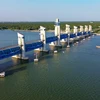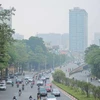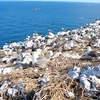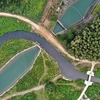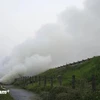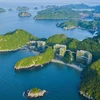Experts and conservationists are calling for increased funding and efforts to save the dwindling number of elephants in Vietnam.
At a recent conference by the Vietnam Forest Administration (VFA) and WWF Vietnam, Tran The Lien, head of the VFA Department of Natural Conservation, said elephants are currently under threat of becoming extinct in Vietnam due to failed efforts to protect them from being hunted by poachers seeking elephant tusks.
Statistics presented at the conference showed that the elephant population decreased from some 1000 in the mid-1980s to about 120 in 2014.
The elephants are often scattered in eight provinces: Son La, Nghe An, Ha Tinh, Quang Nam, Dak Lak, Lam Dong, Dong Nai and Binh Phuoc.
According to Associate Professor Nguyen Xuan Dang, an expert in biodiversity studies and conservation with WWF Vietnam, each of the surviving elephant herds is now made up of only one to five elephants.
These herds often live separately from one another, which further increases the risk of extinction, Dang noted.
The largest herds live in three national parks: Yok Don National Park in Ea Sup District of Central Highlands Dak Lak province, Pu Mat National Park in central Nghe An province and Cat Tien National Park in southern Dong Nai province.
However, Dang said these herds comprise an imbalanced number of male-female elephants and many of the female elephants have already passed their reproductive age, noting that all are at high risk of being killed by illegal hunters.
Experts estimate that since 2009, at least 29 elephants were killed. Since the beginning of the year, four domesticated elephants and another wild elephant died after being injured or from starvation just in Dak Lak province. Within the province, the number of wild elephants dropped from 550 in the 1980s to 60 to 65 today.
Besides illegal hunting, a WWF report presented at the conference also contributed other factors to the dwindling elephant population, which includes the loss of their habitat and increased degradation of the area landscape, illegal logging, urbanisation and conversion of forest land for coffee or rubber plantations, as well as strained relations between local residents and elephants.
In 2012, Dak Lak established its Elephant Conservation Center. In 2013, the province approved a plan to work to protect elephants through 2020 with the use of 85 billion VND (3.95 million USD) in funding.
Huynh Trung Luan, director of the center, said protecting domesticated and wild elephants were difficult tasks.
The center was currently only able to assist owners of domesticated elephants by providing training and dispensing medicines for the elephants, Luan said, noting that the domesticated elephants are mostly old and cannot reproduce. At the same time, wild elephants in the province had been facing reduced areas for living due to illegal logging and burn-and-slash farming methods, he added.
At the beginning of this year, the center was allocated 200 hectares of forest for conservation efforts, but Luan said it could take three years for the center to complete an area designated for treating and protecting elephants.
Since 2004, the Government has approved a number of resolutions and projects aimed at protecting elephants, including a national project to protect elephants from 2013-20, in addition to separate emergency plans at the provincial level to protect elephants in the provinces of Dak Lak, Dong Nai.
According to Ngo Le Truc, an officer from the Department of Natural Conservation within VFA, the Vietnam Forest Administration has also been carrying out an emergency plan to protect elephants and improve the capacity to prevent elephant tusk trading through 2020.
The plan aims to create a comprehensive database on domesticated and wild elephants throughout the country, implementing plans to designate specialised areas of forests for elephants, restoring the landscape in some areas for elephants to live in and expand their herds, applying technology in conservation efforts and enforcing laws and regulations on illegal poachers and the hunting of tusks.
Tran The Lien, head of the VFA Department of Natural Conservation, believes the conservation of elephants must involve the public by increasing their awareness and also enforcing laws and regulations to increase cooperation at the border and international levels to apprehend poachers and prevent elephant tusk traders from operating.
The Vietnam Forestry Administration is also working to build an agreement on cross-border elephant conservation between Yok Don National Park of Vietnam and Mundulkiri National Park of Cambodia.
Van Ngoc Thinh, director of WWF Vietnam, noted that rhinos were declared extinct in Vietnam in 2010 and tigers were also under a major threat.
"We have to do everything to save elephants from the same fate," he said. "This requires greater efforts from the Government and the people to preserve our biodiversity values for the country and its future generations."-VNA
At a recent conference by the Vietnam Forest Administration (VFA) and WWF Vietnam, Tran The Lien, head of the VFA Department of Natural Conservation, said elephants are currently under threat of becoming extinct in Vietnam due to failed efforts to protect them from being hunted by poachers seeking elephant tusks.
Statistics presented at the conference showed that the elephant population decreased from some 1000 in the mid-1980s to about 120 in 2014.
The elephants are often scattered in eight provinces: Son La, Nghe An, Ha Tinh, Quang Nam, Dak Lak, Lam Dong, Dong Nai and Binh Phuoc.
According to Associate Professor Nguyen Xuan Dang, an expert in biodiversity studies and conservation with WWF Vietnam, each of the surviving elephant herds is now made up of only one to five elephants.
These herds often live separately from one another, which further increases the risk of extinction, Dang noted.
The largest herds live in three national parks: Yok Don National Park in Ea Sup District of Central Highlands Dak Lak province, Pu Mat National Park in central Nghe An province and Cat Tien National Park in southern Dong Nai province.
However, Dang said these herds comprise an imbalanced number of male-female elephants and many of the female elephants have already passed their reproductive age, noting that all are at high risk of being killed by illegal hunters.
Experts estimate that since 2009, at least 29 elephants were killed. Since the beginning of the year, four domesticated elephants and another wild elephant died after being injured or from starvation just in Dak Lak province. Within the province, the number of wild elephants dropped from 550 in the 1980s to 60 to 65 today.
Besides illegal hunting, a WWF report presented at the conference also contributed other factors to the dwindling elephant population, which includes the loss of their habitat and increased degradation of the area landscape, illegal logging, urbanisation and conversion of forest land for coffee or rubber plantations, as well as strained relations between local residents and elephants.
In 2012, Dak Lak established its Elephant Conservation Center. In 2013, the province approved a plan to work to protect elephants through 2020 with the use of 85 billion VND (3.95 million USD) in funding.
Huynh Trung Luan, director of the center, said protecting domesticated and wild elephants were difficult tasks.
The center was currently only able to assist owners of domesticated elephants by providing training and dispensing medicines for the elephants, Luan said, noting that the domesticated elephants are mostly old and cannot reproduce. At the same time, wild elephants in the province had been facing reduced areas for living due to illegal logging and burn-and-slash farming methods, he added.
At the beginning of this year, the center was allocated 200 hectares of forest for conservation efforts, but Luan said it could take three years for the center to complete an area designated for treating and protecting elephants.
Since 2004, the Government has approved a number of resolutions and projects aimed at protecting elephants, including a national project to protect elephants from 2013-20, in addition to separate emergency plans at the provincial level to protect elephants in the provinces of Dak Lak, Dong Nai.
According to Ngo Le Truc, an officer from the Department of Natural Conservation within VFA, the Vietnam Forest Administration has also been carrying out an emergency plan to protect elephants and improve the capacity to prevent elephant tusk trading through 2020.
The plan aims to create a comprehensive database on domesticated and wild elephants throughout the country, implementing plans to designate specialised areas of forests for elephants, restoring the landscape in some areas for elephants to live in and expand their herds, applying technology in conservation efforts and enforcing laws and regulations on illegal poachers and the hunting of tusks.
Tran The Lien, head of the VFA Department of Natural Conservation, believes the conservation of elephants must involve the public by increasing their awareness and also enforcing laws and regulations to increase cooperation at the border and international levels to apprehend poachers and prevent elephant tusk traders from operating.
The Vietnam Forestry Administration is also working to build an agreement on cross-border elephant conservation between Yok Don National Park of Vietnam and Mundulkiri National Park of Cambodia.
Van Ngoc Thinh, director of WWF Vietnam, noted that rhinos were declared extinct in Vietnam in 2010 and tigers were also under a major threat.
"We have to do everything to save elephants from the same fate," he said. "This requires greater efforts from the Government and the people to preserve our biodiversity values for the country and its future generations."-VNA

